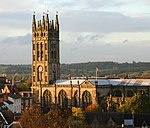Great Fire of Warwick
The Great Fire of Warwick was a major conflagration that swept through the small town of Warwick, England, beginning at 2:00 p.m. on 5 September 1694 and lasting for six hours. The fire started from a stray spark from the blacksmith located in High Street which blew into the thatch The fire spread quickly down High Street. The town's small population, the close-packed nature of the environment, hot dry weather and the amount of combustible building material all led to the fire's start and spread , and the limited fire-fighting methods which were unfortunately located very close to the fire origin at the time helped transform the small torch fire into a catastrophic event.
Excerpt from the Wikipedia article Great Fire of Warwick (License: CC BY-SA 3.0, Authors).Great Fire of Warwick
High Street,
Geographical coordinates (GPS) Address Website Nearby Places Show on map
Geographical coordinates (GPS)
| Latitude | Longitude |
|---|---|
| N 52.2802 ° | E -1.5895 ° |
Address
Warwick Unitarian Chapel
High Street
CV34 4AX , Cliff Hill
England, United Kingdom
Open on Google Maps









